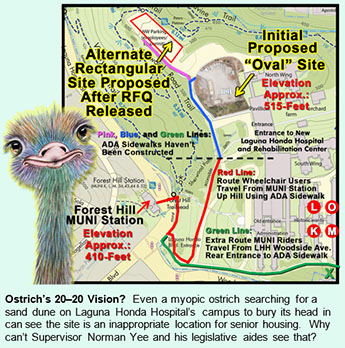 October 5, 2020
October 5, 2020Isolating Seniors on Parking Lot Is Inhumane
LHH: Inappropriate for Senior Housing
Printer-friendly PDF file
 October 5, 2020
October 5, 2020
Isolating Seniors on Parking Lot Is Inhumane
LHH: Inappropriate for Senior Housing
by Patrick Monette-Shaw
In order to slow the spread of COVID in our beloved City nursing home and protect its residents, Laguna Honda Hospital’s entire campus — including its hiking and dirt bike trails system encircling the campus — has been locked down to members of the public and under quarantine for nearly seven months, since March 6, due to the coronavirus pandemic. Visitation to patients remains a huge problem.
Is LHH really a good spot to build senior housing at? If housing is added to the campus, how long will it take before the housing, too, is quarantined in the next inevitable pandemic?
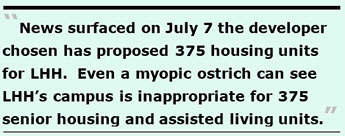 Thirty months ago, Supervisor Norman Yee pitched a proposal to the Mayor’s Office of Housing and Community Development (MOHCD) in March 2018 to build 160 units of senior housing on Laguna Honda Hospital’s (LHH’s) campus.
Thirty months ago, Supervisor Norman Yee pitched a proposal to the Mayor’s Office of Housing and Community Development (MOHCD) in March 2018 to build 160 units of senior housing on Laguna Honda Hospital’s (LHH’s) campus.
MOHCD promptly shot down Yee’s proposal, saying LHH’s campus “wasn’t big enough,” as I wrote in July 2018. Indeed, the Assisted Living Workgroup of the so-called Long-Term Care Coordinating Council (LTCCC) — created by then-Mayor Newsom to guide the development of development of an integrated system of home, community-based, and institutional long term care services for older adults and adults with disabilities — appears to oppose Yee’s LHH housing proposal. The LTCCC prefers smaller six-bed facilities spread throughout the City, not “Monster-in-the-Mission”-sized developments.
 Like a dog with a bone — or an ostrich in search of a sand dune — Yee pressed ahead, pushing his housing proposal. At long last, news quietly surfaced on July 7 that Mercy Housing California has been chosen as the developer for the LHH housing project, after Mercy proposed building up to 375 units of independent housing and assisted living units on LHH’s campus. Few San Franciscans have heard that Mercy Housing was chosen, because MOHCD has kept the news quiet and it hasn’t been covered by our local major news media.
Like a dog with a bone — or an ostrich in search of a sand dune — Yee pressed ahead, pushing his housing proposal. At long last, news quietly surfaced on July 7 that Mercy Housing California has been chosen as the developer for the LHH housing project, after Mercy proposed building up to 375 units of independent housing and assisted living units on LHH’s campus. Few San Franciscans have heard that Mercy Housing was chosen, because MOHCD has kept the news quiet and it hasn’t been covered by our local major news media.
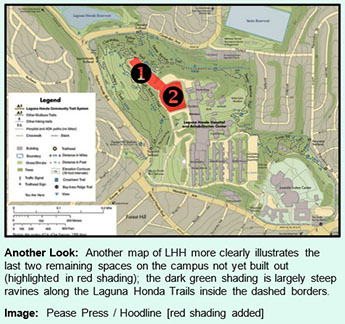 If LHH was too small for 160 units, how is it now suddenly big enough for up to 375 units?
If LHH was too small for 160 units, how is it now suddenly big enough for up to 375 units?
Several hurdles remain. The first hurdle is that MOHCD admits Mercy hasn’t yet demonstrated or proven the entire project — including the independent senior housing units, separate assisted living units, a childcare center, and an Adult Day Health Center (ADHC) — is financially feasible, which project bidders had known all along is the key requirement. As of July 17, Mercy hadn’t submitted a financial feasibility analysis. What’s taking Mercy so long?
Multiple Reasons Why LHH Is an Inappropriate Site
As I wrote in May 2020 (and said long before), I have thought all along Yee’s pitch to place housing on LHH’s campus was a terribly misguided idea from the very beginning. Illustrations in this article are worth a 1,000 words, showing why LHH is the wrong place for Yee’s housing project.
While LHH is touted as having a 62-acre campus, there’s actually very little land that could be pressed into service for housing. Take a good close look at the map of LHH’s campus, to the right. Essentially, only two spots on the campus are viable for construction, both on the northwest side of the campus, because most of the campus has already been built out for the replacement hospital completed in 2010. Many of the old hospital buildings that had been slated for demolition were never torn down. They were repurposed, instead, into being office spaces for the Department of Public Health, despite not being seismically safe and riddled with asbestos.
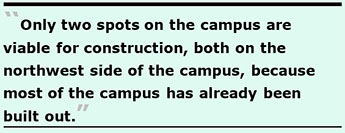 There are many more reasons why the housing proposed for LHH’s campus is inappropriate.
There are many more reasons why the housing proposed for LHH’s campus is inappropriate.
Eliminates Future Expansion of the Hospital for Surge Capacity
The spots where Yee and MOHCD envision placing housing on LHH’s campus are the last two large pieces of undeveloped land on the campus for construction. If Yee succeeds in placing senior housing on the same spot as the 420-bed skilled nursing tower that was eliminated due to cost overruns on the LHH replacement facility rebuild, it will permanently impede the City’s ability to build out additional medical facilities on LHH’s campus as the City’s population increases to address hospital surge capacity citywide.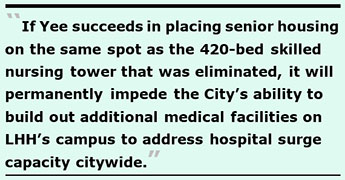 As it is, San Francisco is woefully short of skilled nursing facilities (SNFs) as our population continues to age. Since 2006, when the LHH rebuild project began and the 420 SNF beds were eliminated due to cost overruns, hospitals across the City have discharged over 1,722 patients to out-of-county facilities because of our severe shortage of SNF beds in-county. Those folks were disenfranchised, not re-integrated into their San Francisco communities. If anything, LHH’s campus should be used to build out the 420-bed SNF tower eliminated, to stop the massive out-of-county patient dumping, not housing.
As it is, San Francisco is woefully short of skilled nursing facilities (SNFs) as our population continues to age. Since 2006, when the LHH rebuild project began and the 420 SNF beds were eliminated due to cost overruns, hospitals across the City have discharged over 1,722 patients to out-of-county facilities because of our severe shortage of SNF beds in-county. Those folks were disenfranchised, not re-integrated into their San Francisco communities. If anything, LHH’s campus should be used to build out the 420-bed SNF tower eliminated, to stop the massive out-of-county patient dumping, not housing.
In addition, if housing is placed on the site of the northwest parking lot, it would remove a 145-car parking lot for staff and visitors, which may well lead to the City having to build a replacement parking garage on the remaining parking lot located on the far east side of the campus at the rear of the hold hospital (sometimes referred to as the M-5 parking lot) to accommodate both LHH staff, and visitors to both the hospital and the housing units.
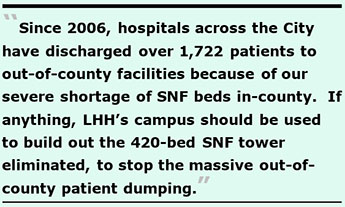 Any so-called “extra” land zoned for hospitals like at LHH should be used to meet the need for long-term care beds by building out more permanent acute-care hospital and skilled nursing bed capacity — or temporary hospital facilities — rather than doing a land grab for housing on public lands to create legacies for outgoing politicians like Mr. Yee.
Any so-called “extra” land zoned for hospitals like at LHH should be used to meet the need for long-term care beds by building out more permanent acute-care hospital and skilled nursing bed capacity — or temporary hospital facilities — rather than doing a land grab for housing on public lands to create legacies for outgoing politicians like Mr. Yee.
Lack of Neighborhood-Serving Retail
There’s absolutely no neighborhood-serving retail within a two-block radius of the Laguna Honda Hospital campus, or even an eight-block radius. After hiking three to flour blocks down the hills to even get off of LHH’s campus and perhaps over to the Forest Hill MUNI station, there are no retail shops anywhere close to the campus. The two or three restaurants at the bottom of the hill near the campus typically close early each evening — assuming they are still in business after COVID.
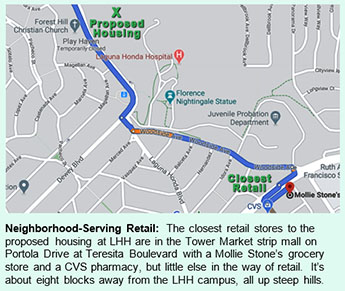 The closest grocery store and pharmacy — Mollie Stone’s and CVS — are on Portola Drive, at least an eight-block walk up steep hills, and difficult to access by public transportation.
The closest grocery store and pharmacy — Mollie Stone’s and CVS — are on Portola Drive, at least an eight-block walk up steep hills, and difficult to access by public transportation.
It’s not as if neighborhood-serving retail is going to come to the area any time soon, or ever, since it’s an enclave of singe-family homes.
Inadequate Public Transportation
It’s unclear if MOHCD had concerns about the lack of transportation when it turned Yee down the first time in 2018, and it’s also unclear whether public transportation will be studied fully before building housing on LHH’s campus.
Laguna Honda Hospital operates and funds a wheelchair accessible shuttle van using hospital employees to provide transportation for hospital employees and visitors between the Forest Hill MUNI Station and the hospital’s main entrance in its new Pavilion building. Problem is, the shuttle van only operates five days a week, every 30 minutes between 6:30 a.m. and 6:00 p.m., leaving employees, patients, and visitors without a transportation van on weekends and during evening hours.
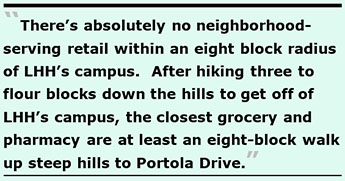 Transportation and Parking Impacts
Transportation and Parking Impacts
My July 2018 article announced that while researching the LHH housing project I unexpectedly stumbled across news hiding in public records that rather than demolishing the old “finger wings” at the rear of the old main hospital, the Department of Public Health produced records in June 2018 announcing it would renovate LHH’s old “M” and “O” patient “finger wings” into administrative offices for up to 480 DPH employees being relocated from the Civic Center area, funding the project by issuing $60 million in Certificates of Participation, which don’t require voter approval but do require being repaid with interest on the principal. Construction was anticipated to start in 2020 and be completed by mid-2021.
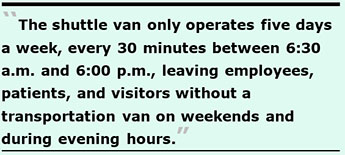 Of interest, the two buildings are 82- to 90-years-old, originally built in 1930 and 1938, and require seismic retrofitting. The two buildings had previously been targeted for complete asbestos and hazardous materials abatement before being completely demolished. Along came COVID-19 and the renovation of the two buildings hasn’t started, now nine months into the year.
Of interest, the two buildings are 82- to 90-years-old, originally built in 1930 and 1938, and require seismic retrofitting. The two buildings had previously been targeted for complete asbestos and hazardous materials abatement before being completely demolished. Along came COVID-19 and the renovation of the two buildings hasn’t started, now nine months into the year.
Obviously, adding almost 500 more employees to the campus will affect transportation in the neighborhoods, and on-campus parking.
If the three seven-story building housing project is placed on both of the so-called “alternative” spots on the campus — on the Northwest Parking Lot — and on the initial “oval” lot proposed, it will remove approximately 145 parking spaces on LHH’s campus. Where will all of those cars for staff and visitors park?
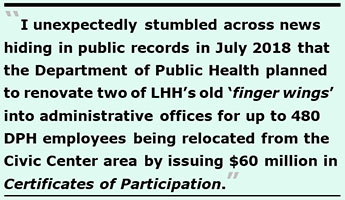 In addition, Yee’s senior housing proposal seeks to build a childcare center for an unknown number of preschoolers being dropped off, and an outpatient Adult Day Health Care (ADHC) facility on the campus for an unknown number of patients needing daily healthcare, both of which will increase drop-off and pick-up transportation for the kids and the elderly, daily.
In addition, Yee’s senior housing proposal seeks to build a childcare center for an unknown number of preschoolers being dropped off, and an outpatient Adult Day Health Care (ADHC) facility on the campus for an unknown number of patients needing daily healthcare, both of which will increase drop-off and pick-up transportation for the kids and the elderly, daily.
Massive COP Funding Increase
When the Health Department first announced in July 2018 the renovation of LHH’s old patient wings into office space, the project was pegged at $60 million. That price tag didn’t last long.
A City Controller’s memo dated August 31, 2020 surfaced recently, showing the price tag of the COP’s for the LHH office conversion project had jumped to at least at least $73 million, if not higher due to financing costs, plus interest on the principal amount.
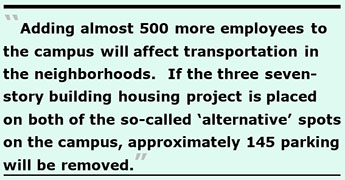 The new report said the project had been switched to the “K” and “M” finger wings. A subsequent records request uncovered that during the past two years the City fretted that it would lose a potential new site for future additional development on the campus using the location of the “L” and “O” finger wings. Wanting to preserve the “O” wing for potential demolition for future development or other re-use, the City switched the COP’s to renovating the “K” and “M” wings. (Again, take another look at the illustration at the top of this article, showing the four wings labeled in red circles on the lower right-hand side.)
The new report said the project had been switched to the “K” and “M” finger wings. A subsequent records request uncovered that during the past two years the City fretted that it would lose a potential new site for future additional development on the campus using the location of the “L” and “O” finger wings. Wanting to preserve the “O” wing for potential demolition for future development or other re-use, the City switched the COP’s to renovating the “K” and “M” wings. (Again, take another look at the illustration at the top of this article, showing the four wings labeled in red circles on the lower right-hand side.)
As designs progressed, structural engineering consultants informed the City that seismic renovation of the “M” wing was somehow tied structurally to the “O” wing. That delay tacked on $13 million, pushing costs from $60 million to $73 million.
 During this two-year delay, Department of Public Works staff also realized the project could not simply replace selective windows — apparently included in the initial $60 million budget — but all windows would need to be replaced to meet the goal of a “natural ventilation ”system. DPW also identified additional seismic upgrades are necessary, and full hazardous abatement is required, rather than localized abatement. DPW’s concerns tacked on an additional $11 million, pushing the budget for needed COP funding for the same project to $84 million, plus interest, across just two years, which represents a 40% change increase since 2018.
During this two-year delay, Department of Public Works staff also realized the project could not simply replace selective windows — apparently included in the initial $60 million budget — but all windows would need to be replaced to meet the goal of a “natural ventilation ”system. DPW also identified additional seismic upgrades are necessary, and full hazardous abatement is required, rather than localized abatement. DPW’s concerns tacked on an additional $11 million, pushing the budget for needed COP funding for the same project to $84 million, plus interest, across just two years, which represents a 40% change increase since 2018.
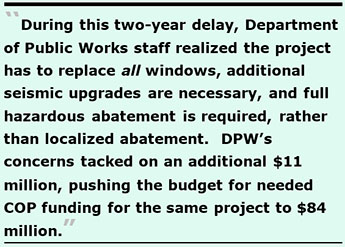 As a result, the Controller’s August 31 memo indicated the project had been forced to revert back this September to the “M” and “O” finger wings, as initially envisioned.
As a result, the Controller’s August 31 memo indicated the project had been forced to revert back this September to the “M” and “O” finger wings, as initially envisioned.
Turns out, the pro-rata share apportionment of interest on the COP’s just for the LHH renovation portion of the larger DPH Exit Strategy project will require approximately $52.4 million in interest payments, pushing the LHH renovation to a total price tag of $136.4 million.
Since I used to work in LHH’s “K” wing for a decade, I can vouch for just how worried rehabilitation and other medical clinicians (and I) were about the friable asbestos throughout the building, even lurking in the radiator system.
All of those wings were to have been fully abated, and then completely torn down as part of the initial LHH rebuild project that opened in 2010, but the abatement and demolition were eliminated from the rebuild project due to massive cost over-runs!
 Indeed, the original budget for the LHH replacement hospital was just $401 million, including abatement and complete demolition of the finger wings. But massive costs over-runs by DPW and the construction manager — Turner Construction and Anshen + Allen — resulted in $195 million in cost over-runs, pushing the LHH replacement hospital project budget to $596 million.
Indeed, the original budget for the LHH replacement hospital was just $401 million, including abatement and complete demolition of the finger wings. But massive costs over-runs by DPW and the construction manager — Turner Construction and Anshen + Allen — resulted in $195 million in cost over-runs, pushing the LHH replacement hospital project budget to $596 million.
Adding the now $136.4 million in principal and interest on COP’s to renovate just the “O” and “M” wings to the $194 million in costs over-runs effectively pushes the total cost over-runs for the complete LHH rebuild to a staggering $330 million. That $330 million could have fully-funded building the 240-bed patient tower eliminated before 2010.
 On December 4, 2007 San Francisco’s Health Commission adopted a resolution urging acceptance of a report that 240 units of assisted living be built as a Residential Care Facility (RCFE) for the Elderly on LHH’S campus on the exact same spot as the “K,” “L,” “M,” and “O” wings, and that “the buildings should be constructed as [soon as] financing becomes available.” But over the past 13 years, neither the City nor the Heath Commission has lifted so much as a pinky finger to identify sources of funding for the assisted living units.
On December 4, 2007 San Francisco’s Health Commission adopted a resolution urging acceptance of a report that 240 units of assisted living be built as a Residential Care Facility (RCFE) for the Elderly on LHH’S campus on the exact same spot as the “K,” “L,” “M,” and “O” wings, and that “the buildings should be constructed as [soon as] financing becomes available.” But over the past 13 years, neither the City nor the Heath Commission has lifted so much as a pinky finger to identify sources of funding for the assisted living units.
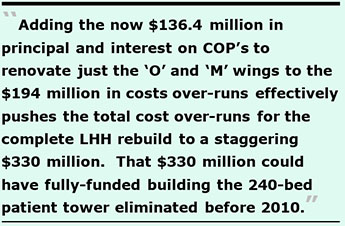 Rather than spending $136.4 million to renovate the two 90-year-old buildings, wouldn’t it make more prudent fiscal sense to demolish both of the two wings completely, and dedicate that $136.4 million toward new buildings that could last for another 90 years? This a prime example of why COP-funded projects are so bad for San Franciscans, which should be funded by capital improvement funds from the General Fund.
Rather than spending $136.4 million to renovate the two 90-year-old buildings, wouldn’t it make more prudent fiscal sense to demolish both of the two wings completely, and dedicate that $136.4 million toward new buildings that could last for another 90 years? This a prime example of why COP-funded projects are so bad for San Franciscans, which should be funded by capital improvement funds from the General Fund.
Plan to Avoid an EIR or CEQA Review
As I’ve also previously written, MOHCD and the Department of Public Health are hoping to shoehorn the 375-unit housing project onto the EIR conducted in 2002 for the rebuild of LHH’s replacement hospital to prevent having to perform another CEQA review. In addition, there’s the increase of almost 500 additional DPH employees to office space on LHH’s campus.
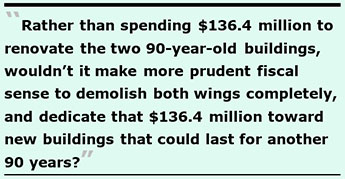 Adding a minimum of 875 more people to the campus every day can’t possibly not have an impact on the environment and on transportation in the surrounding neighborhoods.
Adding a minimum of 875 more people to the campus every day can’t possibly not have an impact on the environment and on transportation in the surrounding neighborhoods.
Proposed Housing Site Is Even More Isolated
The Department of Public Health completed a transit analysis in 2014 to give San Francisco neighborhoods an average “health facility transit score.” Transit service areas were defined by (1) Total trip time to a health facility is less than 30 minutes, (2) No walking portions of the trip are over a quarter of a mile, and (3) There is not more than one transfer between transit lines. The Potrero Hill Health Center (PHHC), a safety net clinic serving primarily low-income residents, was one of the facilities surveyed to assess the extent that transportation barriers impact patients’ access to the clinic and health outcomes.
Among other things, the survey found:
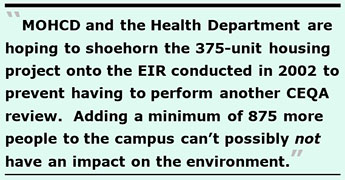 Over 30% of PHHC patients cannot comfortably walk more than one block up a steep hill.
Over 30% of PHHC patients cannot comfortably walk more than one block up a steep hill.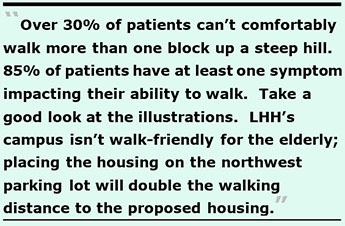 Take another good look at the illustrations in this article. The campus isn’t walk-friendly for the elderly and disabled.
Take another good look at the illustrations in this article. The campus isn’t walk-friendly for the elderly and disabled.
The pink, blue, red, and dark green lines represent sidewalk areas on the campus. As the drawing illustrates, placing the housing on either of the two potential sites will double the distance MUNI riders will face climbing the ADA sidewalk up the hill to LHH, and will significantly increase transportation barrier impacts on patients’ access to the housing. This bears repeating: Placing the housing on LHH’s northwest parking lot will double the walking distance to the proposed housing.
The red line in the illustration is the ADA sidewalk built during the 2010 LHH rebuild only to the entrance of the new hospital, which is thought to be ¼-mile long. The red segment has a barely ADA-compliant sidewalk only up the lower half of LHH’s front lawn along West Clarendon Road that splits the hillside in half.
The blue and pink lines represent the distance from the entrance of the new hospital to the proposed housing site(s), which currently do not have any sidewalks, let alone ADA-compliant sidewalks.
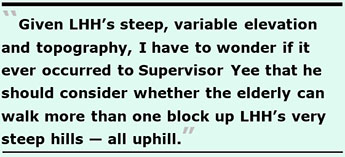 And if MUNI riders access the LHH campus using the Woodside Avenue and Ulloa Street entrance to the campus using MUNI’s #44-O’Shaughnessy bus route, they’ll have to ambulate even further (shown by the green line). The green segment between Woodside Avenue and Dewey Boulevard has extremely narrow, decades-old decrepit sidewalks, which are essentially dangerous for people using wheelchairs or walking with canes.
And if MUNI riders access the LHH campus using the Woodside Avenue and Ulloa Street entrance to the campus using MUNI’s #44-O’Shaughnessy bus route, they’ll have to ambulate even further (shown by the green line). The green segment between Woodside Avenue and Dewey Boulevard has extremely narrow, decades-old decrepit sidewalks, which are essentially dangerous for people using wheelchairs or walking with canes.
Just like geographic proximity and/or public transit availability to a health care facility is a significant measure of health care access, so too is geographic proximity and public transit availability to senior housing.
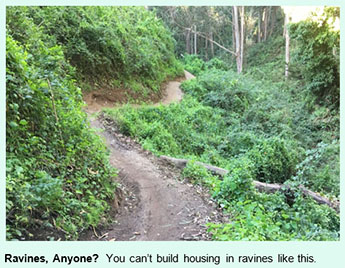 Given LHH’s steep and variable topography and elevation, I have to wonder if it ever occurred to Supervisor Yee he should consider whether the elderly he wants to housing create for on LHH’s campus can comfortably walk more than one block up LHH’s very steep hills, since the distance is four or more blocks away — all uphill — from the Forest Hill MUNI station.
Given LHH’s steep and variable topography and elevation, I have to wonder if it ever occurred to Supervisor Yee he should consider whether the elderly he wants to housing create for on LHH’s campus can comfortably walk more than one block up LHH’s very steep hills, since the distance is four or more blocks away — all uphill — from the Forest Hill MUNI station.
Little Flat Land and Steep Ravines
There is next to no flat land remaining on the LHH campus, which has largely already been built out. The large swaths shaded in green in the two campus maps are actually heavily forested open space land riddled with steep ravines that form the Laguna Honda Trails encircling the campus.
Even chopping down the urban tree canopy along the east side of Laguna Honda Boulevard between Woodside Avenue and Clarendon Avenue wouldn’t yield space to build housing, because of the steep ravines and slope of the hillsides shown in the photo (courtesy of Hoodline). You can’t build housing in steep ravines.

Joe Bravo Ignores Project Scope Creep
On January 6, 2020 the San Francisco Chronicle reported that Joe Bravo, a prominent Forest Hill neighbor, supports the resurrection of Yee’s LHH housing proposal:
“ ‘That is where I think it belongs — on a level surface, not on a hill,’ [Bravo] said. ‘That is a proper place for it and a proper use of land at Laguna Honda Hospital. It’s less isolated than the other project would have been. It’s consistent with what we were saying when we opposed’ the Christian Church development.”
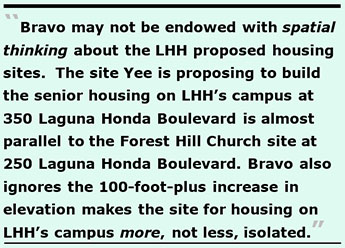
Bravo could not be more wrong about the LHH campus being “less isolated,” and placing housing on LHH’s campus is a “proper use” of the flat land. For one thing, moving the senior housing project from 250 Laguna Honda Boulevard to 350 Laguna Honda Boulevard is more isolated, not less isolated, given the increased elevation and site terrain, and the long distance to cross the campus to any housing. Bravo also was misleading: The Forest Hill Church site was, in fact, flat land, not “on a hill.” Admittedly, there was a steep hill behind that site.
Bravo may not be endowed with spatial thinking when it comes to the location of the proposed housing sites. The site Yee is proposing to build the senior housing on the far northwest parking lot on LHH’s campus at 350 Laguna Honda Boulevard is almost parallel to the Forest Hill Church site at 250 Laguna Honda Boulevard. Bravo also ignores the 100-foot-plus increase in elevation definitely makes the site for housing on LHH’s campus more, not less, isolated.
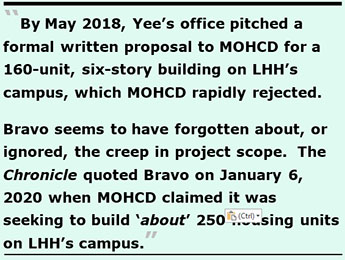 Forest Hill neighbors are clearly sensitive to their image as wealthy single-family homeowners who oppose affordable housing in their neighborhoods. That was hogwash, but they were unfairly criticized as having been solely responsible for the collapse of the proposed 150-unit senior housing project on the Forest Hill Church property at 250 Laguna Honda Boulevard after Yee withdrew his support for that project, now two-and-a-half- years ago on March 8, 2018.
Forest Hill neighbors are clearly sensitive to their image as wealthy single-family homeowners who oppose affordable housing in their neighborhoods. That was hogwash, but they were unfairly criticized as having been solely responsible for the collapse of the proposed 150-unit senior housing project on the Forest Hill Church property at 250 Laguna Honda Boulevard after Yee withdrew his support for that project, now two-and-a-half- years ago on March 8, 2018.
In reality, MOHCD later clarified that neighborhood opposition had no effect on MOHCD’s decision to withdraw funding support of the project, and that MOHCD’s decision was based entirely on the geotechnical report saying the hillside behind the church posed a danger of homes collapsing down that hillside. MOHCD noted the impact that had on the financial viability of the project.
Within days of withdrawing his support for the Forest Hill Church project, Yee’s staff first contacted MOHCD on March 13, 2018 about placing “assisted living” and/or RCFE (Residential Care Facilities for the Elderly) units on LHH’s campus, just six days after MOHCD had ended the 150-unit senior housing project. By May 2018, Yee’s office pitched a formal written proposal to MOHCD for a 160-unit, six-story building on LHH’s campus, a proposal MOHCD rapidly rejected as to big for LHH’s campus.
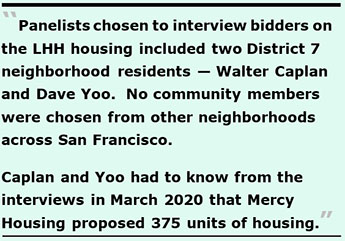 Bravo seems to have forgotten about, or ignored, the creep in project scope. The Forest Hill Church project proposal was initially presented to District 7 Supervisor Norman Yee as a 50-unit project, but it inexplicably grew without warning to a 150-unit project. When the Chronicle quoted Bravo on January 6, 2020 it claimed MOHCD’s RFQ was seeking to build “about” 250 housing units on LHH’s campus.
Bravo seems to have forgotten about, or ignored, the creep in project scope. The Forest Hill Church project proposal was initially presented to District 7 Supervisor Norman Yee as a 50-unit project, but it inexplicably grew without warning to a 150-unit project. When the Chronicle quoted Bravo on January 6, 2020 it claimed MOHCD’s RFQ was seeking to build “about” 250 housing units on LHH’s campus.
MOHCD’s selection panelists chosen to interview bidders on the LHH Housing RFQ included seven people, including two District 7 neighborhood residents hand-picked by Supervisor Norman Yee — Walter Caplan, to represent the Forest Knolls Neighborhood, and Dave Yoo, to represent the Forest Hills Homeowners Association. No other community members were chosen from other neighborhoods across San Francisco.
However, when MOHCD’s selection panel finally interviewed bidder proposals in early March 2020 and selected Mercy Housing, public records finally revealed the scope of the project has grown to 375 units. Caplan and Yoo had to have known from the bidder interviews that Mercy Housing had proposed 375 units of housing and was selected as the developer.
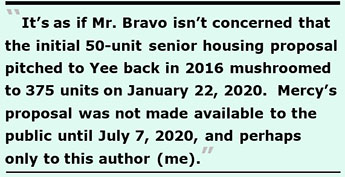 MOHCD confirmed on August 3, 2020 that Mercy’s proposal was for up to 300 units for the independent senior housing component of the project plus an additional 75 units for assisted living, for a total of 375 units. Mercy’s proposal was “conceptual” and has not been finalized, so the total units may increase or decrease depending on available project funding secured, and whether the project demonstrates financial viability.
MOHCD confirmed on August 3, 2020 that Mercy’s proposal was for up to 300 units for the independent senior housing component of the project plus an additional 75 units for assisted living, for a total of 375 units. Mercy’s proposal was “conceptual” and has not been finalized, so the total units may increase or decrease depending on available project funding secured, and whether the project demonstrates financial viability.
It’s as if Mr. Bravo — and perhaps neighborhoods surrounding LHH’s campus — is not at all concerned that the initial 50-unit senior housing proposal pitched to Yee back in 2016 had mushroomed to 160 units in May 2018, and then mushroomed again to 375 units on January 22, 2020, more than septuple the 50 units first pitched to Yee. Mercy’s 375-unit sevenfold increase 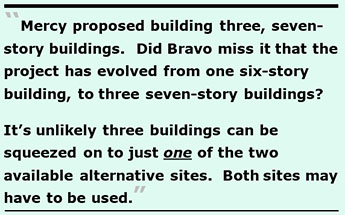 proposal was not made available to members of the public until July 7, 2020, and then perhaps only to this author (me).
proposal was not made available to members of the public until July 7, 2020, and then perhaps only to this author (me).
Indeed, Mercy submitted a proposal on January 22 to build three, seven-story buildings, using Type III over Type 1 construction. Type III projects are buildings with only fire-resistant exterior walls, and are typically not more than five-story buildings. How has Bravo missed it that the project has evolved from one six-story building, to three seven-story buildings? (An answer to that question may be that MOHCD doesn’t seem to have posted the winning bidder’s proposal and name on-line as of September 15 and it hasn’t been covered in the mainstream media, so perhaps Bravo hasn’t heard.)
Take another look at the maps, above. It’s unlikely three buildings can be squeezed on to just one of the two available alternative sites. Both sites may have to be used for a project of this scale.
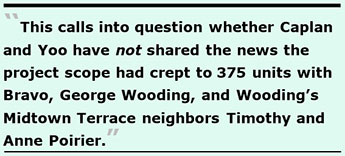 This calls into question whether Caplan and Yoo have not shared the news the project scope had crept to 375 units with Bravo, George Wooding, and Wooding’s Midtown Terrace neighbors Timothy and Anne Poirier, homeowners who live on Olympia Way and who wrote to Mayor Breed and Supervisor Yee on February 8, 2020 that the “… proposed 250 apartments is an enormous project totally out of scale with the surrounding neighborhoods.”
This calls into question whether Caplan and Yoo have not shared the news the project scope had crept to 375 units with Bravo, George Wooding, and Wooding’s Midtown Terrace neighbors Timothy and Anne Poirier, homeowners who live on Olympia Way and who wrote to Mayor Breed and Supervisor Yee on February 8, 2020 that the “… proposed 250 apartments is an enormous project totally out of scale with the surrounding neighborhoods.”
The Poirier’s were clearly frustrated that “neighbors surrounding the proposed site have not received any formal notification of the proposed plans.” Now eight months after writing their letter, the Poirier’s have probably still not received any notice and may be unaware the “massive” 250-unit project mushroomed to 375 units.
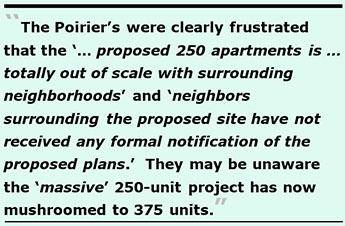 An Elephant in the Room: No Price Tag
An Elephant in the Room: No Price Tag
While Yee’s housing proposal has been floating around City Hall for now two-and-a-half years, we haven’t been told what the price tag is.
Back on March 5, 2019 MOHCD’s then-director, Kate Hartley, prepared a back-of-an-envelope estimate. She estimated Yee’s proposal would cost $224.9 million, but $32 million in potential tax credits meant the City would only have to identify the remaining $192.9 million to complete the funding package.
Unfortunately, Hartley’s calculations were based on just 250 independent senior housing units, 30 RCFE beds, the childcare center, and the Adult Day Health Center, plus a 15% contingency of $29.3 million. But the project mushroomed to 300 independent senior housing units (not 250), 75 RCFE beds (not 30), plus the childcare and ADHC components.
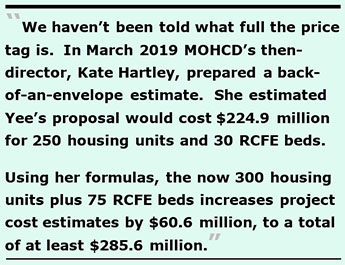 Using her formulas, the now combined 375 units increases projected cost estimates by $60.6 million, to a total of $285.6 million. Assuming the tax credits stay constant at $32 million, the City will still have to locate $253.6 million to complete the project. Both Yee and MOHCD have failed to date to identify what funding source(s) are being considered, although one prominent Midtown Terrace homeowner believes Yee will use $100 million from the $600 million 2019 Affordable Housing Bond, which opens up a completely different can of worms about why 300 residential units are being reserved for a single supervisorial district (D7), rather than smaller projects scattered throughout all San Francisco neighborhoods.
Using her formulas, the now combined 375 units increases projected cost estimates by $60.6 million, to a total of $285.6 million. Assuming the tax credits stay constant at $32 million, the City will still have to locate $253.6 million to complete the project. Both Yee and MOHCD have failed to date to identify what funding source(s) are being considered, although one prominent Midtown Terrace homeowner believes Yee will use $100 million from the $600 million 2019 Affordable Housing Bond, which opens up a completely different can of worms about why 300 residential units are being reserved for a single supervisorial district (D7), rather than smaller projects scattered throughout all San Francisco neighborhoods.
No Community-Driven Input and Review
Yee’s community outreach to date on his housing proposal is completely nonexistent, and pathetic.
As I have written several times during the past three years, and again in September, there has been absolutely zero community-driven input or review regarding Yee’s proposal to build housing on LHH’s campus, and there has been nothing transparent about it since Yee first pitched his proposal back in March 2018.
First, another records request revealed Yee organized, scheduled, and held two small-group meetings with only neighbors in the Forest Hill, Forest Hill Extension, and Midtown Terrace neighborhoods to solicit initial responses to his continuum of care concept in the “vicinity of Laguna Honda Hospital.” The meetings were apparently held on May 24, 2019 and August 6, 2019 prior to release of MOHCD’s RFQ. The two meetings were reportedly by-invitation-only, not open-to-the-public meetings. Yee’s office indicated the meeting attendees included Fr. Mesrop Ash, Evernease McKnight, Walter Caplan, Dena Williams, George Wooding, Andrew Sparks, David Yoo, Peggy de Silva, and Janis and Frank Lee.
Yee claims he addressed five other organizations as part of limited public outreach, which were held between December 2018 and January 2020 before news surfaced in July 2020 that the project has grown to 375 units. Those meetings also appear to have been invitation-only meetings targeted to their members, not members of the general public.
 Second, there also have been zero public hearings before the full Board of Supervisors or before San Francisco’s Public Health Commission (which essentially owns LHH’s land) during the past two-and-a-half years, and neither the Board nor the Commission have approved Yee’s hairbrained proposal to build housing on LHH’s campus. Both approvals are required.
Second, there also have been zero public hearings before the full Board of Supervisors or before San Francisco’s Public Health Commission (which essentially owns LHH’s land) during the past two-and-a-half years, and neither the Board nor the Commission have approved Yee’s hairbrained proposal to build housing on LHH’s campus. Both approvals are required.
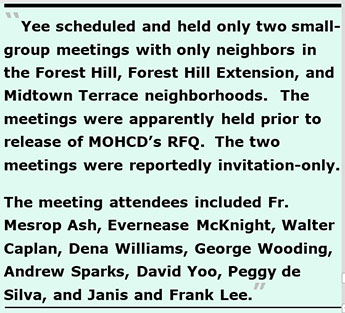 Finally, the six candidates running to replace Yee as D7 Supervisor appear to have agreed developments that change neighborhoods for generations to come deserve robust community-driven review. Will there ever be robust community review of Yee’s housing proposal?
Finally, the six candidates running to replace Yee as D7 Supervisor appear to have agreed developments that change neighborhoods for generations to come deserve robust community-driven review. Will there ever be robust community review of Yee’s housing proposal?
Monette-Shaw is a columnist for San Francisco’s Westside Observer newspaper, and a member of the California First Amendment Coalition (FAC) and the ACLU. He operates stopLHHdownsize.com. Contact him at monette-shaw@westsideobserver.com.